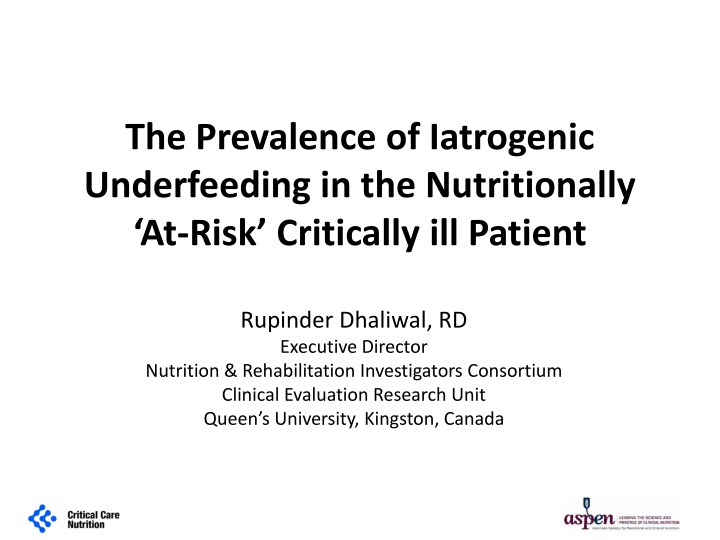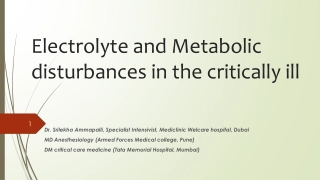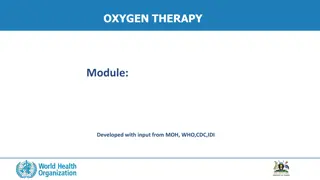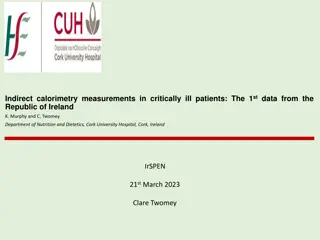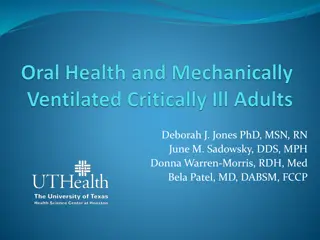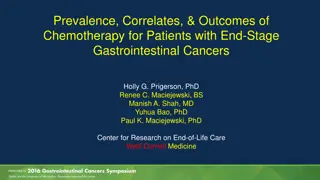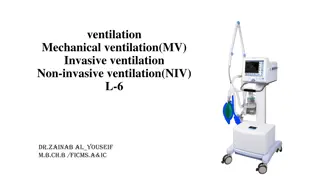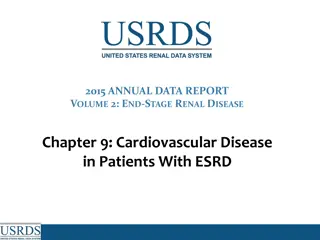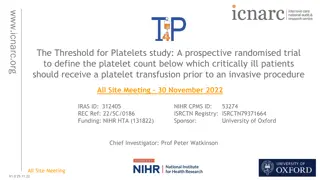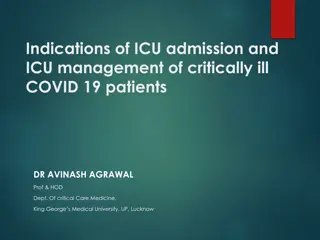Prevalence of Iatrogenic Underfeeding in Critically Ill Patients
Critically ill patients often receive only half of their prescribed energy and protein needs, leading to iatrogenic underfeeding which can have adverse consequences. Research shows the impact on mortality rates, ventilator-free days, and the benefits of nutrition therapy based on NUTRIC score and duration of mechanical ventilation.
Download Presentation

Please find below an Image/Link to download the presentation.
The content on the website is provided AS IS for your information and personal use only. It may not be sold, licensed, or shared on other websites without obtaining consent from the author.If you encounter any issues during the download, it is possible that the publisher has removed the file from their server.
You are allowed to download the files provided on this website for personal or commercial use, subject to the condition that they are used lawfully. All files are the property of their respective owners.
The content on the website is provided AS IS for your information and personal use only. It may not be sold, licensed, or shared on other websites without obtaining consent from the author.
E N D
Presentation Transcript
The Prevalence of Iatrogenic Underfeeding in the Nutritionally At-Risk Critically ill Patient Rupinder Dhaliwal, RD Executive Director Nutrition & Rehabilitation Investigators Consortium Clinical Evaluation Research Unit Queen s University, Kingston, Canada
Introduction Critically ill patients receive only 50% prescribed energy and protein needs Prescribed Engergy 2000 Energy Received From Enteral Feed 1800 1600 1400 Caloric debt 1200 kcal 1000 800 600 400 200 0 1 3 5 7 9 11 13 15 17 19 21 Days This underfeeding , considered to be IATROGENIC, could lead to adverse consequences However, not all critically ill patients seemed to be harmed more as a consequence of iatrogenic underfeeding
Who benefits from nutrition therapy in in the ICU?
Multicenter observational study, 2772 patients For every increase of 1000 calories per day reduction in overall 60-day mortality (p=0.014) increase in ventilator-free days (p=0.003) Beneficial treatment effect of increased calories was only observed in: BMI<25 and >35 no benefit in BMI 25-<35 group
NUTrition Risk in the Critically ill Score (NUTRIC Score) severity of the underlying illness the degree of acute markers of inflammation and starvation indices the degree of chronic markers of inflammation and starvation indices Helps discriminate which ICU patients will benefit more (or less) from aggressive protein-energy provision NUTRIC score 6 (out of 10) may benefit the most from nutrition therapy
Mechanically ventilated > 7 days Underfeeding in pts mechanically ventilated >7 days WORSE outcomes! Energy deficit of ~1200 kcals/day is associated with an independent likelihood of ICU death (Faisy et al British J Nutrition 2009) Recent randomized trials FAIL to show a difference in the group that received the most calories (Casaer et al NEJM 2011, Rice et al Crit Care Med 2011) Why so? 1. BMI mid ranges 2. Patients young, few comorbidities, so low NUTRIC 3. short stays in ICU (<5 days on average)
What is optimal nutrition? Heyland DK Crit Care Med 2011 Analyzed patients who were mechanically ventilated and in the ICU for 96 hrs or > Receiving up to 80% of their prescribed energy requirements is associated with a reduced mortality (>80-85% no added effect) We posit that nutritionally at-risk pts should receive at least 80% prescribed needs Focus on patients that stayed in the ICU 96 hrs
Objective describe the prevalence of Iatrogenic Underfeeding (receiving < 80% prescribed energy and protein) in ICUs across different Geographic areas in high risk patients subgroups (those with > 7 days of mechanical ventilation) body mass index (BMI) of <25 and >35 those with a NUTRIC score of >6 compared to low risk patients to determine those ICU and hospital characteristics associated with optimal nutrition practice (lowest rates of iatrogenic underfeeding)
Methods Analysis of data from May 11, 2011 prospective, multi-institutional audit 193 ICUs in 29 countries collected data ~20 pts per ICU, ICU LOS at least 96 hrs 3174 mechanically ventilated patients Geographical regions Sites were divided approximately by continent Canada, US separate as many ICUs Sites from countries or continents with too few sites to comprise a unique region were compared to similar region of practice Mexico & South Africa
Data Collection For each patient patient characteristics and ICU admission information baseline nutrition assessment method of calculation (e.g. indirect calorimetry, predictive equations) total calories and protein prescribed daily nutrition data for first 12 days or IC d/c whatever first Route i.e. EN or PN total calories and protein prescribed patient outcomes ICU and hospital discharge and mortality. Duration of mechanical ventilation web-based electronic data capture system
Statistical Approach adequacy of total nutrition during the first 12 days in ICU % percent of caloric and protein prescriptions received from EN or PN SOFA score and IL-6 was dropped from the original NUTRIC score high vs. Low NUTRIC: according to median NUTRIC Score (i.e. patients with NUTRIC > median were classified as high risk subgroup) multivariable analysis was performed to examine the association between the prevalence of iatrogenic underfeeding repeated using three different sets of adjustments to account for # days in evaluation (first few days patients receive < 80%) added covariates (ICU characteristics and patient characteristics) simultaneously included high risk factors in addition to all covariates used
n = 193 ICUs, 29 countries, 3174 patients Canada: 20 (20%) Asia: 41 (21%) USA: 45 (23%) Europe and South Africa: 25 (13%) Latin America: 24 (12%) Australia & New Zealand: 39 (20%)
ICU Characteristics Characteristics Total (n=193) Hospital Type Teaching Non-teaching 149 (77.2%) 44 (22.8%) Size of Hospital (beds) Mean (Range) 633 [100- 2600] ICU Structure Open Closed Other 49 (25.4%) 140 (72.5%) 4 (2.1%) Size of ICU (beds) Mean (Range) 17.7 [5 - 65] 182 (94.3%) 153 (79.3%) Designated Medical Director Presence of Dietitian(s) FTE Dietitians (per 10 beds) Mean (Range) 0.4 [0 -3.3]
ResultsPatient Flow Diagram 2011 International Nutrition Survey 3747 patients from 193 ICUs 29 countries 573 Excluded from analysis 378 in ICU <96 hours 195 nutritional adequacy not available for at least 4 days Total used in analysis 3174 patients from 193 ICUs 29 countries 1013 patients 350 patients 1812 patients > 7 days of mechanical ventilation 1533 patients with NUTRIC > 4 with BMI 35 with BMI <25
Patient Characteristics Australia and NZ Europe and South Africa Latin America Total Canada USA Asia p values N 3174 361 602 670 416 442 683 Age (years) mean (SD) 60.3(17.8) 64.6(16.0) 58.2(17.8) 61.5(17.2) 58.8(17.1) 56.7(19.4) 62.0(17.7) <0.001 Sex 1884 (59.4%) Male (%) 191 (52.9%) 365 (60.6%) 353 (52.7%) 260 (62.5%) 257 (58.1%) 458 (67.1%) <0.001 Admission Medical 2031 (64.0%) 260 (72.0%) 370 (61.5%) 474 (70.7%) 224 (53.8%) 284 (64.3%) 419 (61.3%) 0.01 Elective surgery 361 (11.4%) 35 (9.7%) 74 (12.3%) 53 (7.9%) 56 (13.5%) 28 (6.3%) 115 (16.8%) Emergent surgery 782 (24.6%) 66 (18.3%) 158 (26.2%) 143 (21.3%) 136 (32.7%) 130 (29.4%) 149 (21.8%) Weight (kg) mean (SD) 76.3(24.5) 78.2(24.2) 81.1(25.2) 86.3(31.9) 77.9( 20.2) 71.3(16.3) 63.6(14.4) < 0.001 BMI < 0.001 26.9(7.5) 27.8(7.6) 27.9(7.7) 29.8(9.9) 26.8(6.5) 25.9(5.1) 23.7(4.7) mean (SD) APACHE II mean (SD) 21.9(7.7) 23.7(7.1) 22.2(7.9) 22.4(7.4) 21.5(8.2) 19.9(7.1) 21.9(7.7) 0.06 NUTRIC >4 161 (44.6%) 173 (28.7%) 230 (34.3%) 139 (33.4%) 107 (24.2%) 203 (29.7%) 0.002 NUTRIC <=4 200 (55.4%) 429 (71.3%) 440 (65.7%) 277 (66.6%) 335 (75.8%) 480 (70.3%)
Nutrition Outcomes (all patients) Europe and South Africa p values Australia and NZ Latin America Total Canada USA Asia N 3174 361 602 78% of patients failed to meet 80% of energy target 670 416 442 683 Prescribed kcal/kg/day Mean (SD) 24.1(5.5) 23.3 (5.3) 25.5(5) 21.5 (6.2) 24.6(5) 24. 5(4.6) 25.4 (5.2) <0.001 Adequacy of calories % Mean (SD) 56 (30.6 ) 63.4(27.3 ) 59.5(27.7 ) 47.8(27.2 ) 54.4(30.3 ) 53.4(27.9 ) 59.8(37.2 ) <0.001 Adequacy of protein % Mean (SD) 51.5(29.2 ) 59.7(27.2 ) 53.9(27.3 ) 44.1(27.0 ) 49.5(29.6 ) 51.1(28.1 ) 53.9(32.7 ) <0.001 Prevalence of iatrogenic underfeeding 2467 (77.7%) 255 (70.6%) 450 (74.8%) 599 (89.4%) 309 (74.3%) 372 (84.2%) 482 (70.6%) <0.001 Time to initiate EN from ICU admission in hours Mean (SD) 41.7 (43.6) 37.0 (42.8) 32.6 (39.9) 52.3 (43.8) 39.5 (41.7) 48.6 (42.3) 39.2 (46.4) <0.001
Nutrition Outcomes: vented > 7 days Total MV <7days >7 days > 7 d mechanical ventilation Nutritional adequacy % mean (SD) 56 62.8 (29.0)** 47.1 (30.5) Adequacy of calories Better calorie adequacy (30.6 ) 51.5 (29.2 ) 58.0 (27.7)** 42.9 (29.1) Adequacy of protein Better protein adequacy Time to initiate EN from ICU admission in hours 41.7 (43.6 ) 44.1 (46.9 )** 38.3 (38.0) Mean (SD) Longer to start EN Prevalence of iatrogenic underfeeding 2467 (77.7%) 1295 (71.5%)** 1172 (86.1%) N (%) Lower prevalence underfeeding (all values p<0.01)
Nutrition Outcomes (BMI) Total BMI 25-34 BMI 35 vs. 25-34 BMI < 25 vs. 25-34 <25 35 Nutritional adequacy % mean (SD) Better calorie adequacy (p 0.01-0.05) Better calorie adequacy 56 57.8 (32.4)** 54.0 (28.7) 55.6 (29.6)* Adequacy of calories (30.6 ) No difference Better protein adequacy 51.5 (29.2 ) 53.5 (30.2)** 50.1 (28.3) 47.9 (27.7) Adequacy of protein Time to initiate EN from ICU admission in hours No difference Shorter time to EN 41.7 (43.6 ) 38.6 (41.0 )** 44.8 (45.6) 44.4 (46.2) Mean (SD) No difference Prevalence of iatrogenic underfeeding Lower prevalence underfeeding all values p<0.01 2467 (77.7%) 1136 (74.1%)** 1058 (82.0%) 273 (78.0%) N (%)
Nutrition Outcomes (NUTRIC score) Total NUTRIC score NUTRIC Score > 4 <4 >4 Nutritional adequacy % mean (SD) 56 55.3 (29.8) 56.4 (31.0) No difference Adequacy of calories (30.6 ) 51.5 (29.2 ) 51.3 (29.1) 51.2 (29.3) No difference Adequacy of protein Time to initiate EN from ICU admission in hours No difference 41.7 (43.6 ) 43.6 (45.0) 40.8 (42.9) Mean (SD) Prevalence of iatrogenic underfeeding 2467 (77.7%) 788 (77.8%) 1679 (77.7%) N (%) No difference
Multivariate analysis (odds of receiving <80% of prescription) Adjusting for number of days included in nutrition assessment Adjusting for all covariates* but not other risk factors of interest Adjusting for all covariates* and other risk factors of interest. Risk Factors of Interest OR (95% CI) p-value OR (95% CI) p-value OR (95% CI) p-value 0.68 0.67 (0.50-0.90) 0.0077 0.69 (0.51-0.93) 0.016 0.013 (0.51-0.92) MV> 7 days (vs. MV 7 days) BMI < 25 (vs. BMI between 25 and 35) 0.66 0.65 (0.54-0.80) <0.0001 0.67 (0.54-0.83) 0.0002 0.0001 (0.54-0.82) BMI > 35 (vs. BMI between 25 and 35) 0.64 0.64 (0.49-0.84) 0.0014 0.64 (0.47-0.86) 0.0036 0.0038 (0.47-0.86) 1.04 1.06 (0.88-1.27) 0.55 1.02 (0.78-1.35) 0.86 0.75 (0.79-1.38) NUTRIC > 4 (vs. NUTRIC 4) being mechanically ventilated for more than 7 days having a BMI <25 and having a BMI 35 were all associated with about a one third reduction in the odds of receiving <80% of energy prescription
Conclusions Worldwide, the majority of critically ill patients fail to receive adequate nutritional intake This rate of failure varies across geographic regions High risk patients are less likely to be underfed than low risk patients but still experience significant underfeeding
Acknowledgements Daren K. Heyland MD, MSc Lauren Murch MSc Xuran Jiang MSc Andrew G. Day MSc Clinical Evaluation Research Unit, Kingston General Hospital Department of Community Health and Epidemiology, Queen s University Department of Medicine, Queen s University Kingston, ON, Canada
References Alberda C, Gramlich L, Jones NE, Jeejeebhoy K, Day A, Dhaliwal R, Heyland DK. The relationship between nutritional intake and clinical outcomes in critically ill patients: Results of an international multicenter observation study. Intensive Care Med 2009;35(10):1728-37. Faisy C, Lerolle N, Dachraoui F, Savard JF, About I, Tadie JM, Fagon JY. Impact of energy deficit calculated by a predictive method on outcome in medical patients requiring prolonged acute mechanical ventilation. British J Nutrition 2009;101:1079-1087. Heyland DK, Dhaliwal R, Jiang X, Day A. Quantifying nutrition risk in the critically ill patient: The development and initial validation of a novel risk assessment tool. Critical Care 2011 Casaer MP, Mesotten D, Hermans G, et al. Early versus late parenteral nutrition in critically ill adults. N Engl J Med 2011;June 29 (epub). Rice T, Morgan S, Hays MA, Bernard GR, Jensen GL, Wheeler AP. Randomized trial of initial trophic versus full-energy nutrition in mechanically ventilated patients with acute respiratory failure. Crit Care Med 2011;39;967-974. Heyland DK, Cahill N, Day A. Optimal amount of calories for critically ill patients: Depends on how you slice the cake! Crit Care Med 2011 Jun 23 (epub).
